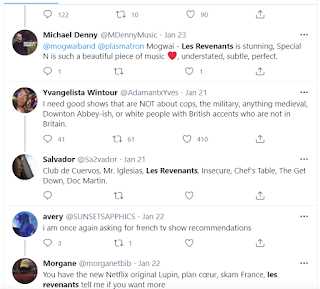Les Revenants - Meanings and Mini Mock
- Les Revenants is an allegory of the inevitability of death.
- It has highly uncommercial themes and ideologies.
- In the two scenes of Camille and Julie coming home.
- Julie subverts hegemonic expectations of how women should look and behave
- There are a range of different characters because everyone deals with grief differently.
- Julie in a later episode we find out has been assulted, this presents to the audience with a complicated and hard to decode set of ideologies.
- It helps to gain a wider viewership with the range of characters.
- E.g. Camille appeals to teenage girls.
Scene: Simon and Léna goes home
How does this scene create multiple meanings for different audiences?
In what ways are men and women represented in this scene?
- Low key lighting - symbolises the emotions of the characters.
- The underpath tunnel, concrete and dark - connotations of crime, this is further anchored and reinforced by the dog barking.
- Music - hegemonic generic paradigm of genre, low and eerie.
- Generic paradigm of horror when Simon tries to get into the house, in the mirror which the woman (Adele) (long take shot) can see him in the refelction it is dark, mirror is symbolic of a character reflecting on themselves and she is presented as a vulnerable and weak woman with only a night dress - she is sexualised.
- Binary opposition of men and women of Simon and Léna.
- Atypical when Le'na she tries to pick up Simon in the bar, she then shouts at Simon being aggressive calling him a 'dickhead'.
- Simon - Stereotypical representation of men, he is aggressive when he is banging on the door and shouting. Conforms to hegemonic heterosexual relationship norms - men are angry and aggressive. He is hegemonically attractive
- Typically sexually active female characters in horror films are killed, when Léna goes off with Simon, nothing bad happens to her. Atypical.
- Escapism to the audience who are younger - we expect these two characters walking home to get together but then we see them going their seperate ways.
- Léna - States she basically lives in the pub, picking up men.
- Adele - Stereotypical hegemonic representation of women in horror - wearing a white dress with low key lighting accentuating her features, she is seen as vulnerable in the scene and starts screaming and crying when Simon comes home.
- Simon is wearing a nice suit - hermenutic code - did he die on his wedding?
- Polysemic interpretations - different audiences may have different interpretations of the meanings of the scene.
''In the 21st century, it is essential for TV shows to offer their audiences multiple meanings'' - evaluate this claim with reference to Les Revenants.
pea
Les Revenants is a French Television series in the horror genre produced by Canal+ for niche audiences with the main narrative of people from the dead coming back to life. An audience is a group of people in which a media text targets, however there are different types of audiences who consume media such as Hall's Reception theory, some audiences are negotiated. I believe it is therefore essential for TV shows to offer multiple meanings.
One way Les Revenants uses multiple meanings is seen in the scene where both Simon and Léna are going home, this uses polysemy when the audience expects both of these characters to get together but then go their seperate ways, this reflects the genre of drama as both characters are cold to eachother creating a binary opposition with when Simon goes home to see Adele and is a generic paradigm to horror with mise-en-scene of a mid shot of Adele looking in her reflection and is hegemonic stereotype of a 'horror girl' as she is vulnerable, she can see Simon admist the night setting with lowkey lighting the audience again suspects her to not be safe as she screams and cries (diegetic) when he knocks on the door aggresssively.This leaves the audience with multiple meanings as a situation leads to another.
Another way in which Les Revenants do this is when Camille comes home, we see a polysemy between Clare and Camille living in seperate scenes. The mother is living in a generic paradigm of a horror seen in the mise-en-scene, with a tracking shot, the audience is positioned with her, hearing noises downstairs in the night setting all alone sets up a scene where the audience is expecting something terrible to happen. We also have a tracking shot of Camille walking back home creating the genre of mystery (Semantics) a hermenutic code to the audience as we have earler seen her die in a crash. We then see the two genres cross over into hybridity when Clare sees Camille, leaving the audience with multiple meanings.
In conclusion Les Revenants is an example of a TV show which creates multiple meanings, therefore I agree with this claim, as audiences can relate to different meanings in a polysemic media product and can attract a wider audience and negotiated reading.



